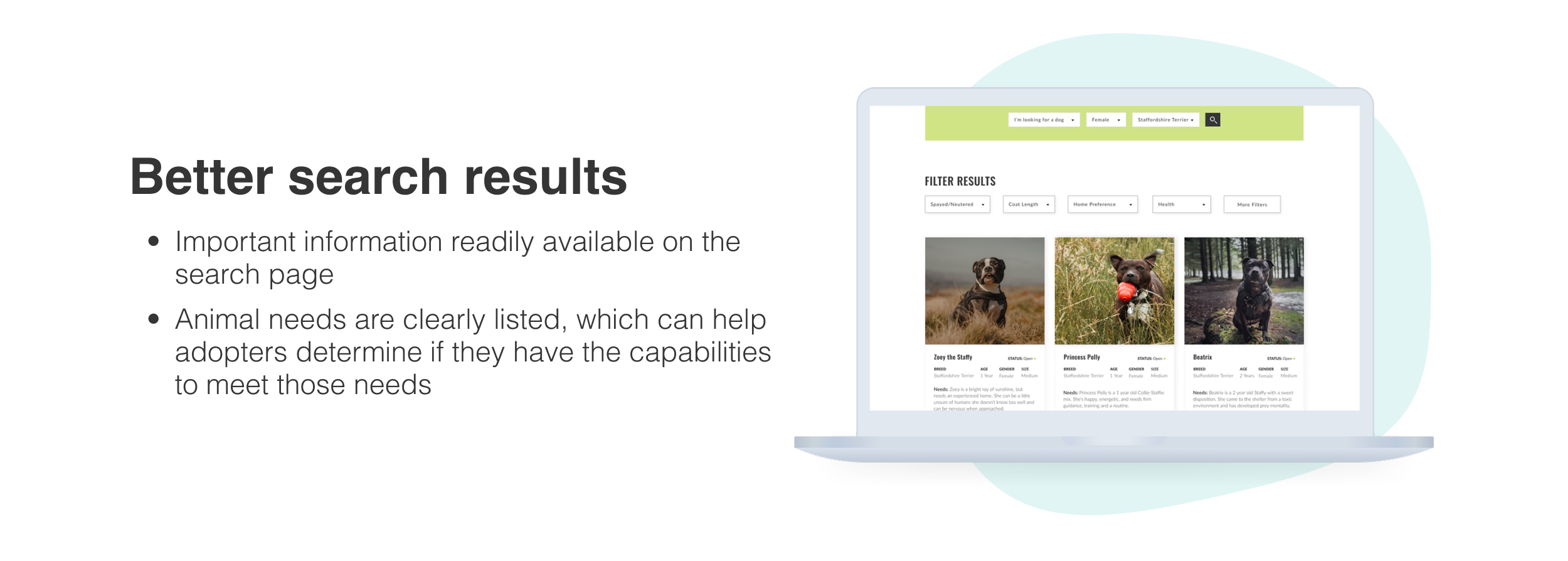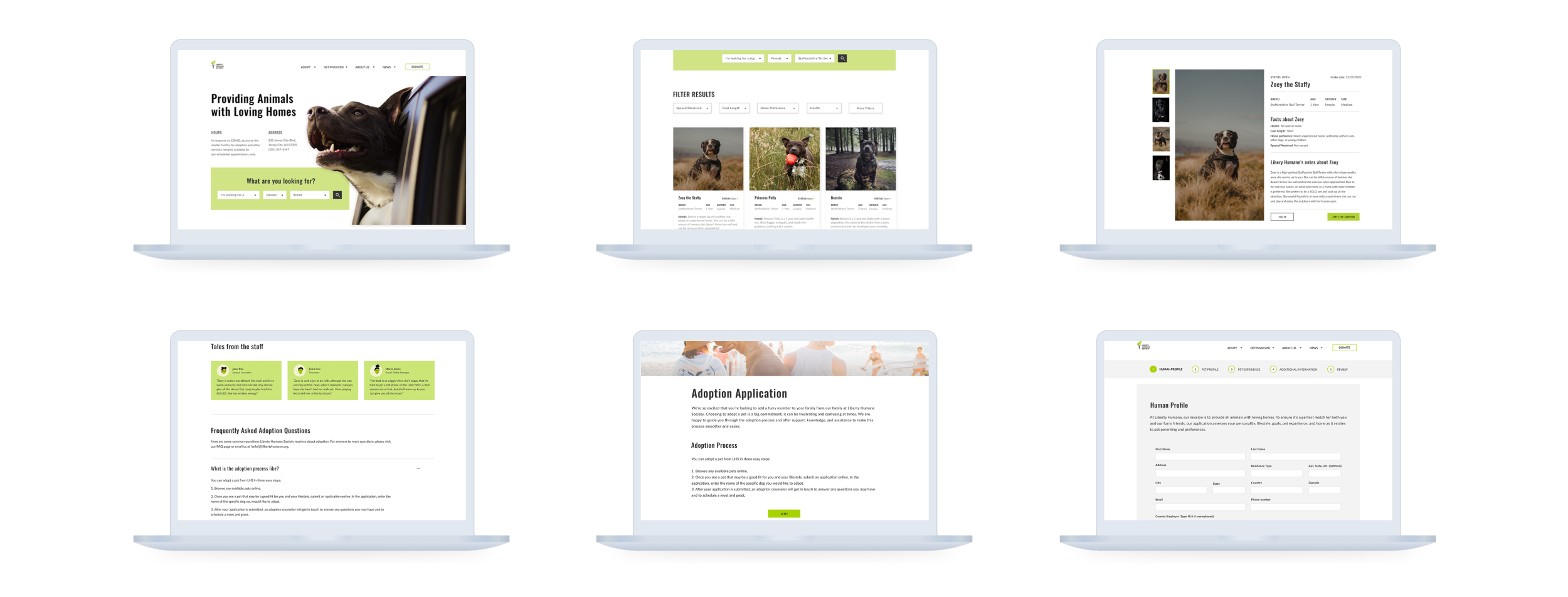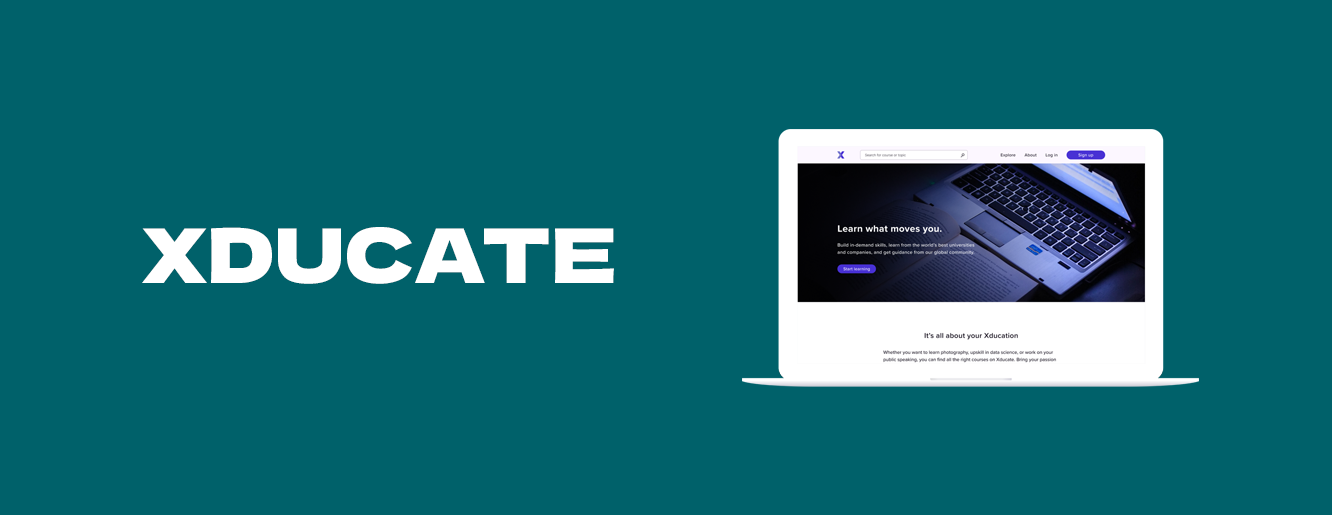Liberty Humane Society
TIMEFRAME
4 weeks
ROLE
Research
Prototyping
Visual Design
Usability Testing
Project Management
PLATFORM
Web
TEAM
Solo
*This is a conceptual project completed as part of my design portfolio.
PROBLEM
Adoption rates are heavily influenced by how well animals are presented to potential adopters.
According to the ASPCA, between 6.3 and 6.5 million animals enter into shelters each year. Out of those, approximately 4.1 million animals are adopted, leaving around 2 million animals that are euthanized or die due to old age or sickness. This sparked the question: what are the most important reasons for animals to be considered for adoption and can we influence those factors?
SOLUTION
How animals are promoted has a big influence of getting them a home.
WHITE PAPER RESEARCH
What was the single most important reason a pet was chosen at a shelter?
I started with white paper research to gather facts and information about potential adopters’ decision-making process. One of the most striking facts I found on the subject (Wells and Hepper) revealed that:
“...on average, the visitors stopped to look at 29% of the total number of dogs available for purchase. When they stopped to look at a dog, visitors spent an average of 70 seconds in front of the animal's cage.”
The average duration of interactions was quite short – only 8 min. Animals only have a small window to convince a human that they’re “the one.” Because of the short amount of time adopters spend with the animals, staff members and volunteers play an important role in guiding the adopters towards animals that best fit their lifestyle and living situation. Whether they planned to adopt a cat or dog, “most people reported that an important source of information about their pet was from a staff member or volunteer. In an age where shelters are spending more time and energy on developing their websites and cutting staff to save money, this study indicates that adopters find no substitute for a person helping them select an animal” (Wells et al. 156).
COMPETITIVE ANALYSIS
Direct and indirect competitors had little to no information on temperament and behavior, and no stories from volunteers and staff.
I studied 4 of the most well known adoption and animal welfare sites to find any similar themes that I can bring to the Liberty Humane website. I found that almost none of them had information that adopters deemed important when it comes to adopting a pet. Some patterns I did find included having a more prominent “donate” button, make pet listings intuitive and visually appealing, and a streamlined adoption application.
USER SURVEY + INTERVIEWS
Interviewees felt frustrated with shelter websites’ search capabilities and wanted firsthand accounts from staff and volunteers about the animals.
All of the interviewees had different approaches to finding their perfect companion. However, 80% of the interviewees visited a shelter website at least once to search. Sixty percent noted that they felt frustrated with the search capabilities and had difficulties filtering through the list of animals. In addition, 80% of the interviewees found it incredibly important to see animals through the shelter staff and volunteers’ eyes. This discovery corresponds to the previous research that found that most people reported a staff member or volunteer as an important source of information about their pet.
THE PET-OBSESSED MILLENNIAL PERSONA
DESIGN
Before any design work, I wanted take some time to improve Liberty Humane’s site architecture. The previous site architecture had an unclear labeling system and an unorganized search system; users found themselves getting lost in a sea of content. To help keep users satisfied and lower bounce rates, I made some improvements by making the architecture more effective in matching user needs. In addition, users found the horizontal navigation bar mildly irritating, so I exchanged it for a more typical vertical horizontal navigation system.
The discussions with adopters shed light on a few other opportunities for improvement for the website in both look and functionality. While the participants were put off by the use of a third party website when searching for pets, they also called attention to the lack of information from the search function results, the daunting and long application, and the overwhelming navigation bar. These problems were among several others identified during user research sessions. Refining the design and then validating our potential solutions to these problems was key to the overall improvement of the functionality of the website.
IMPROVEMENTS
Based on feedback from my mentor and peers, I updated my designs to create my hi-fi prototype.
The final product
USER TESTING
Because of the importance of media in the adoption process, I used a high-fidelity prototype for user testing. The main task that I asked users to complete:
Search for a female American Staffordshire to adopt and apply for adoption
The updated functionality and designs of the website received positive feedback, with many noting the ease of navigation and the clear display of information. Users also noted that the updated search page and animal profiles really showcased the animals in the best way.
Strengths
Easy to navigate
Information was displayed clearly and users were able to get information in a fast and efficient manner
Navigation only displays what is relevant and important
Search page results and the animal profile page really showcase the animals in the best way—the photos are nice and big
Search is seamless
While the feedback was extremely positive, there was still some room for improvement. Adoption fees, for example, could become more prominent on the page. When reviewing application information, many found it a little difficult, so information on that page can be displayed in a better manner.
Room for improvement
Adoption fees can be more prominent—maybe have them somewhere on the profile page and not just in the FAQs
Review of information in the adoption application can be displayed better; it’s a little hard to review
The “learn more” button on search page results can be a little more prominent; the blue is a little hard to read
It’s a little unclear why animals marked “waitlist full” are showing up on the results page
So What's Next?
LEARNINGS
To see the impact of rolling out these updates and new features, some key metrics to keep track of would be the number of completed and abandoned applications on the website and the percentage of animals that were adopted (based on the application submitted on the website) but not returned.
















